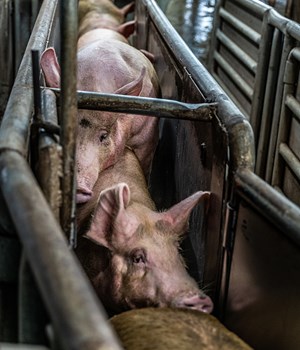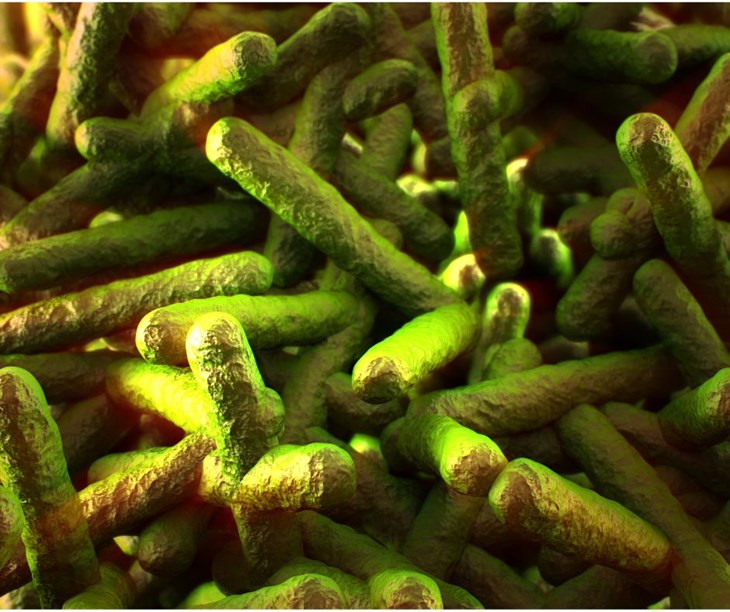4/17/2025
by Alex Cragun
In March 2025, the U.S. Department of Agriculture (USDA) announced plans to permanently increase poultry processing line speeds from 140 to 175 birds per minute. Representatives from the poultry and pork industry tout this change as a path to enhanced efficiency without compromising safety standards. But a closer examination reveals a troubling reality: faster slaughter lines will likely lead to increased animal suffering, more worker injuries, and greater risks to food safety.
Animal Welfare: Speed Equals Suffering
Accelerated line speeds can result in more needless suffering for broiler chickens and pigs.

- In 2024 alone, approximately 18,000 chickens and turkeys (1,500 monthly) were not properly rendered unconscious before reaching the slaughter line and scalding tank
- Documented cases show pigs being subjected to boiling water while still conscious due to inadequate stunning

These failures aren't mere statistics—they represent intense, unnecessary suffering. When slaughter lines move too quickly, proper stunning procedures become harder to implement consistently. As a result, animals experience unimaginable pain and terror in their final moments—a clear ethical failure.
The Human Cost: Worker Safety in Jeopardy
The meat processing industry already has one of the highest injury rates of any sector in America, and increasing line speeds threaten to make this dangerous work even more hazardous:
- Chronic injuries are widespread: 40% of all swine and poultry workers report chronic pain
- Musculoskeletal disorders are endemic: 46% of poultry workers and 80% of swine workers are at high risk for conditions like carpal tunnel syndrome, tendonitis, and arthritis
- Catastrophic injuries occur regularly: Two amputations occur weekly on average in slaughterhouses, with about 17 severe incidents reported monthly
Workers in these facilities already struggle under brutal conditions. Many reports include accounts of workers being denied basic human necessities—bathroom breaks and adequate water—with some resorting to wearing diapers during their shifts. When line speeds increase, fatigue sets in faster, attention lapses become more common, and the risk of life-altering injuries rises dramatically.
Food Safety Risks: When Haste Creates Waste
Perhaps most concerning for consumers is how faster line speeds compromise food safety:
- Rushed inspections: USDA inspectors have less time to examine carcasses to ensure they are safe for human consumption, meaning they are free of abscesses and contamination by foreign objects such as needles, bullets, and broken machinery
- Inadequate sanitation: Workers struggle to properly clean equipment between processing steps
- Increased pathogen risk: Cross-contamination becomes more likely, allowing harmful bacteria to enter the food supply

The consequences can be deadly. A 2024 listeria outbreak in deli meats resulted in 60 hospitalizations and 10 deaths, including an infant. Investigators traced the outbreak to a processing plant with severe sanitation issues—mold, mildew, and insects were found near food-contact surfaces. Such negligence becomes more probable when speed takes priority over safety.
A Better Path Forward: Solutions for Safer Poultry Processing
Alternatives exist that can improve efficiency without sacrificing safety:
1. Controlled Atmosphere Stunning (CAS)For poultry, CAS offers a less painful slaughter method by gradually reducing oxygen levels to render animals unconscious before processing. This approach:
- Eliminates the need for stressful live shackling
- Reduces handling errors that can lead to contamination
- Improves worker safety by reducing animal handling
As part of their participation in the Better Chicken Commitment (BCC), Perdue Chicken has embraced CAS in several of its facilities, providing a better alternative to traditional slaughter methods, such as water bath stunning. Better Chicken compliant producers, such as Miller Poultry, Pitman Farms and Wayne-Sanderson Farms, as part of their participation in the Better Chicken Commitment also using CAS in addition to improving the on-farm living conditions of broiler chickens. This approach offers a model for the industry, demonstrating that it’s possible to prioritize both animal welfare and efficiency in poultry production.
2. Policy Reforms
Several specific policy changes could help create a safer, more ethical meat processing system:
- Reinstate reasonable line speed limits: Return to the 140 birds per minute cap to ensure adequate time for proper handling and inspection
- Expand humane slaughter requirements: Amend the Humane Methods of Slaughter Act (HMSA)--which currently only covers mammals--to include mandatory standards for poultry
- Create transition incentives: Provide tax benefits or funding to help processors adopt safer technologies like CAS
- Strengthen oversight: Give USDA inspectors more resources and authority to enforce safety and welfare standards
The True Cost of Cutting Corners
The drive to increase slaughter line speeds reflects a narrow focus on short-term efficiency gains at the expense of longer-term costs. These costs include:
- Worker compensation claims and lost productivity due to injuries
- Recalls and liability from foodborne illness outbreaks
- Damage to consumer trust when safety failures make headlines
When we factor in these hidden costs, the economic case for ever-faster processing lines becomes much less compelling.
Choosing Safety Over Speed
Line speed regulations aren't arbitrary bureaucratic obstacles—they're vital safeguards that protect workers, animals, and consumers. Just as we wouldn't remove seatbelts from cars to eliminate the time it takes to buckle up, we shouldn't sacrifice safety measures in our food system for marginal productivity gains.
The USDA's decision to raise line speed limits may benefit industry profits in the short term, but it imposes significant costs on society. If we truly value animal welfare, safe working conditions, and food safety, we must demand a better approach—one that recognizes efficiency and ethics aren't mutually exclusive.
By investing in better technologies, maintaining reasonable line speeds, and prioritizing thorough inspections, we can create a meat processing system that delivers safe food without unnecessary suffering. The choice isn't between efficiency and safety—it's between a sustainable food system and one that cuts corners at everyone's expense.
Call to Action
Tell the USDA to protect animals, workers, and public health.

